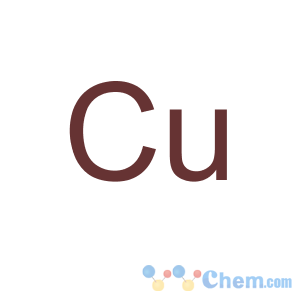Title: Copper
CAS Registry Number: 7440-50-8
Literature References: Cu; at. wt 63.546; at. no. 29; valences 1, 2. Group IB (11). Occurrence in the earth's crust: 70 ppm; also present in seawater: 0.001-0.02 ppm. Two naturally occurring isotopes: 63 (69.09%), 65 (30.91%); nine artificial isotopes: 58-62, 64, 66-68. One of the earliest known metals. Found in nature in its native state; also in combined form in several minerals including chalcopyrite,
q.v., chalcocite,
bornite, (Cu5FeS4),
tetrahedrite (Cu12Sb4S13),
enargite (Cu3AsS4),
antlerite (Cu3H4O8S). Extraction from ores: Clark-Hawley,
Encyclopedia of Chemistry (Reinhold, New York, 2nd ed., 1966) p 288. Metallurgy of copper and its alloys:
Metals Reference Book vols. 1, 2, C. J. Smithells, Ed. (Butterworth's, London, 3rd ed., 1962). A trace element essential to many plants and animals. Occurs in biological complexes such as
pheophytin (analog of chlorophyll), hemocyanin, tyrosinase and ceruloplasmin,
q.q.v. Reviews of copper and copper compounds:
ACS Monograph Series no. 122, entitled "Copper," A. Butts, Ed. (Reinhold, New York, 1954) 936 pp; Massey, "Copper" in
Comprehensive Inorganic Chemistry vol. 3, J. C. Bailar, Jr.
et al., Eds. (Pergamon Press, Oxford, 1973) pp 1-78; W. M. Tuddenham, P. A. Dougall,
Kirk-Othmer Encyclopedia of Chemical Technology vol. 6 (Wiley-Interscience, New York, 3rd ed., 1979) pp 819-869. Book:
Inflammatory Diseases and Copper, J. R. J. Sorenson, Ed. (Humana Press, Clifton, NJ, 1982) 622 pp. Review of role in human diseases: G. J. Brewer,
Curr. Opin. Chem. Biol. 7, 207-212 (2003); of toxicology and human exposure:
Toxicological Profile for Copper (PB2004-107333, 2004) 318 pp.
Properties: Reddish, lustrous, ductile, malleable metal; face-centered cubic structure; commercially available in the form of ingots, sheets, wire or powder. Becomes dull when exposed to air. In moist air gradually becomes coated with green basic carbonate. d 8.94. mp 1083°. bp 2595°. Mohs' hardness 3.0. Resistivity 1.673 microohm-cm. Heat of fusion 48.9 cal/g; heat of vaporization 1150 cal/g. Heat capacity at constant pressure (solid) 0.092 cal/g/°C (20°), (liq) 0.112 cal/g/°C. E0 (aq) Cu+/Cu +0.521 V; E0 (aq) Cu2+/Cu +0.337 V. Very slowly attacked by cold hydrochloric or dil sulfuric acid; readily by dil nitric acid, and by both hot concd H2SO4 and HBr. It is also attacked by acetic and other organic acids. Slowly sol in ammonia water. Water-soluble cupric salts yield with sodium hydroxide a bluish-green precipitate of cupric hydroxide which is changed to black cupric oxide on warming. Potassium ferrocyanide produces a brownish-red precipitate of copper ferrocyanide. Hydrogen sulfide produces in acid solns a black precipitate of cupric sulfide which is sol in soln of sodium cyanide. Aluminum, iron or zinc precipitate metallic copper from its solns.
Melting point: mp 1083°
Boiling point: bp 2595°
Density: d 8.94
CAUTION: Potential symptoms of overexposure to dusts and mists are irritation of eyes, nose, pharynx; nasal perforation; metallic taste; dermatitis. Potential symptoms of overexposure to fumes are irritation of eyes, upper respiratory system; metal fume fever (chills, muscle aches, nausea, fever; dry throat, cough, weakness, lassitude); metallic or sweet taste; discoloration of skin and hair.
See NIOSH Pocket Guide to Chemical Hazards (DHHS/NIOSH 97-140, 1997) p 76.
Use: Manuf bronzes, brass, other copper alloys, electrical conductors, ammunition, copper salts, works of art.

